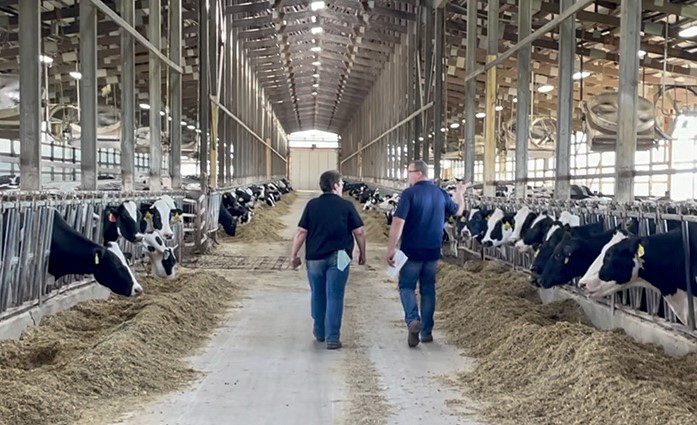Proper mineral and vitamin supplementation in dairy cattle feeding programs is essential to animal health and performance. Optimum feeding of the animal means that the individual nutrients such as vitamins and minerals must be supplied in the right quantities and proportions, since interactions between individual substances may influence their availability and utilization.

Vitamins A, D and E have all been implicated as having a role in maintaining normal reproduction. Minimum requirements, reported in the NRC (1989) in early lactation (IU/lbs. of dry matter intake) are Vitamin A – 1450, Vitamin D – 450 and Vitamin E Nutritionists frequently add these at higher levels to dairy cattle rations to assure an adequate intake.
Vitamin A
A deficiency of vitamin A has a direct effect on the structure and function of the pituitary gland, gonads and uterus. In the hypophysis, it leads to irreversible cystic degeneration. Further deficiencies cause keratinization of endometrium, thus affecting development of the placenta. In the early stages, there is a degeneration of the mucosa of the respiratory tract, mouth, salivary glands, eyes, tear glands, intestinal tract, urethra, kidneys, and vagina. Animals become more susceptible to infection and colds. The first signs of vitamin A deficiency in pregnant cows are shortened gestation periods, a high incidence of retained placentas, and the birth of dead, uncoordinated or blind calves. Blindness or night blindness may also be the first noticeable sign of vitamin A deficiency in growing cattle that are being fed high-concentrate diets. Under hot, humid and stress conditions, the need for vitamin A increases. We recommend the level be increased from 1450 IU/lb (NRC, 1989) to 2500 IU/lb. of ration dry matter.
Vitamin D
Vitamin D is essential for the normal calcification of bones. Some of the first signs of vitamin D deficiency rickets are decreases in the calcium blood plasma concentrations and increases in serum phosphates. These blood changes are associated with characteristic alterations in bones. Vitamin D is implicated in reproductive losses through its effects on phosphorus and calcium utilization. The NRC (1989) recommended level is 450 IU/lb. of dry matter.
Vitamin E and Selenium
Vitamin E and selenium have been used successfully in combination to reduce the incidence of retained placenta, metritis (uterine infection), and cystic ovaries in herds having low levels of these nutrients. Herds having such problems are frequently injected with a vitamin E-selenium compound containing 680 IU of vitamin E and 50 mg of selenium as selenite about three weeks prior to calving. Because other factors are related to retained placenta, such as reproductive diseases and stress conditions, added vitamin E and selenium may not always be helpful in correcting a problem. Although it is not well defined, the new NRC (1989) has recommended the selenium concentration in the ration be increased from 0.1 to 0.3 ppm.
Copper and Magnesium
Deficiencies of copper and magnesium may be related to infertility, anemia or suppressed immune function. In a Louisiana State University study, 204 Holstein cows and heifers were supplemented with copper and magnesium or both minerals to provide up to 150% of NRC recommendations. When compared with cows supplemented with copper or magnesium alone or with neither mineral, cows supplemented with both copper and magnesium improved conception from about 62% to 84% by 150 days postpartum. First-service conception rates for control, copper-supplemented, magnesium-supplemented and copper plus magnesium-supplemented cows were 33%, 27%, 38% and 57%, respectively. Days to first estrus, first service and services/conception were not affected by copper and/or magnesium supplementation. Significant lactation x supplement group interactions suggest that age or milk production may alter the requirements of these minerals. Further research is needed to determine why copper plus magnesium but neither mineral alone improved conception.
Phosphorous and Calcium
Phosphorus and calcium are important major minerals when formulating diets for dairy animals. A phosphorus shortage is more likely to occur than a calcium deficiency under conditions where forages are used more abundantly. Forages tend to be good sources of calcium; concentrates better sources of phosphorus. A phosphorus deficiency has been associated frequently with a reduction in appetite, retarded growth, less efficiency in feed utilization, decreased milk production, and impaired reproduction.
Provided by Virginia Tech Cooperative Extension
Did You Know
A cow’s intestines can get up to 170 feet in length.
A cow’s liver weighs 10 to 12 pounds, and the kidney’s average 20 pounds each.
No two cows have the same pattern of spots.
It takes +/- 3,000 cows to supply the 22,000 footballs, the NFL uses every season.
A cow can’t vomit.
Related Articles & Free Email Newsletter Subscription
Cattle Show to Align North-South When Grazing
How to Preserve Winter Teat Condition in Dairy Cattle
Why Increased Holstein Milk Production Has Decreased Fertility Rates




Comment here